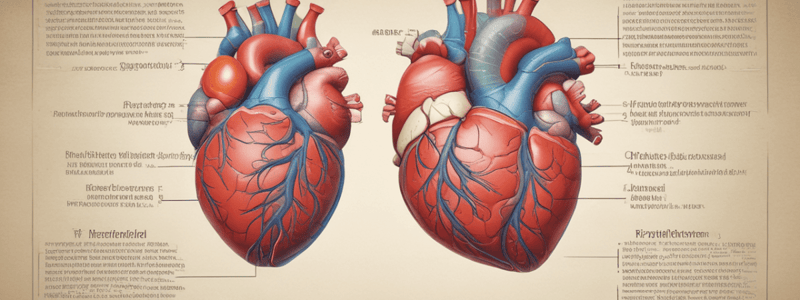Podcast
Questions and Answers
What is the primary function of the pericardium in relation to the heart's movement?
What is the primary function of the pericardium in relation to the heart's movement?
- To allow for maximum mobility of the heart
- To stimulate the heart's contractions
- To fix the heart in the mediastinum and limit its motion (correct)
- To regulate the heart's blood pressure
What is the normal amount of pericardial fluid present in the pericardial space?
What is the normal amount of pericardial fluid present in the pericardial space?
- 50-100ml
- 100-200ml
- 10-20ml
- 20-50ml (correct)
Which of the following is a complication of pericardial effusion?
Which of the following is a complication of pericardial effusion?
- Heart failure
- Cardiac tamponade (correct)
- Myocardial infarction
- Cardiac hypertrophy
Which nerve provides sensory supply to the fibrous and parietal pericardium?
Which nerve provides sensory supply to the fibrous and parietal pericardium?
What is the purpose of the transverse pericardial sinus?
What is the purpose of the transverse pericardial sinus?
What is the term for the referred pain in pericarditis?
What is the term for the referred pain in pericarditis?
Flashcards are hidden until you start studying
Study Notes
Functions of the Pericardium
- Fixes the heart in the mediastinum, limiting its motion, with the heart sitting on the diaphragm
- Prevents overfilling of the heart, with a normal amount of pericardial fluid ranging from 20-50ml, and overfilling occurring when it reaches 100ml
- Provides lubrication
- Offers protection from infection
Pericardium: Clinical Implications
- Pericardial effusion is the acute or chronic accumulation of fluid within the pericardial space, with reasons including infection, inflammatory conditions, cancer/cancer treatments, trauma, and idiopathic causes
- Pericardial effusion can lead to cardiac tamponade, compressing ventricles and resulting in reduced cardiac output and shock
Innervation of Pericardium
- The phrenic nerve (C3-C5) provides sensory supply to the fibrous and parietal pericardium
- Pain sensations are conveyed by these nerves and are commonly referred to the skin (C3-C5 dermatomes)
- The pericardium is a common source of referred pain in pericarditis
Pericardial Sinuses
- The transverse pericardial sinus is a cavity that brings together the primordial arterial and venous ends of the developing heart
- The pericardial oblique reflection is a cavity that forms as veins expand and pericardial reflection is carried out around them
Studying That Suits You
Use AI to generate personalized quizzes and flashcards to suit your learning preferences.



